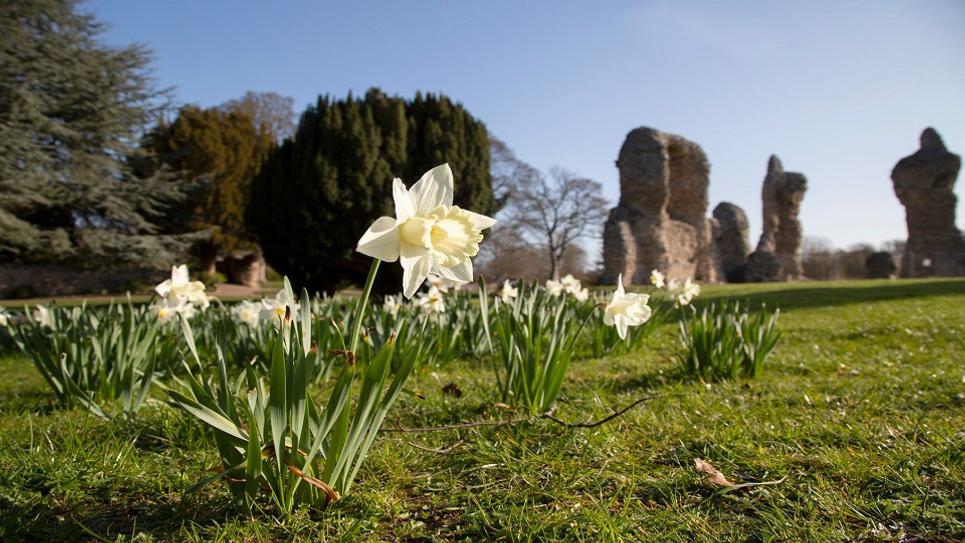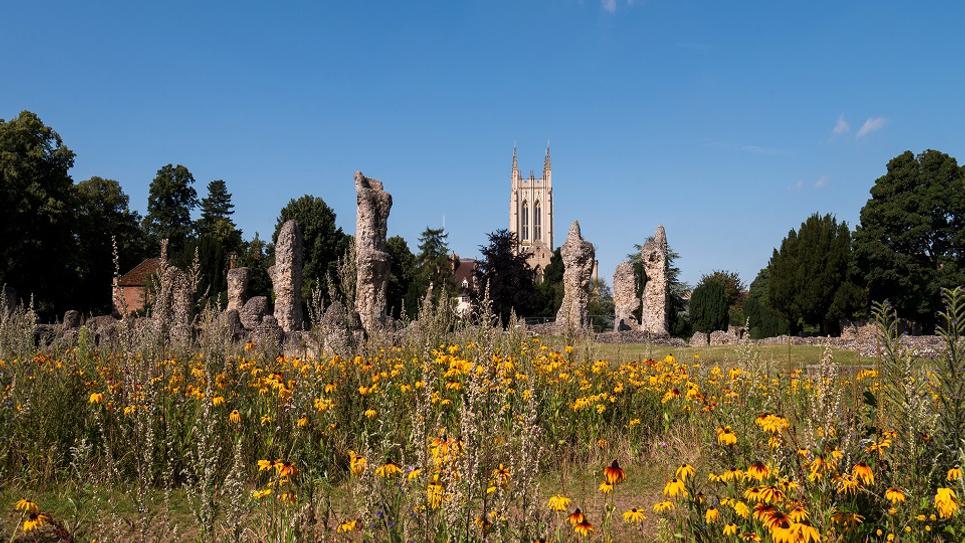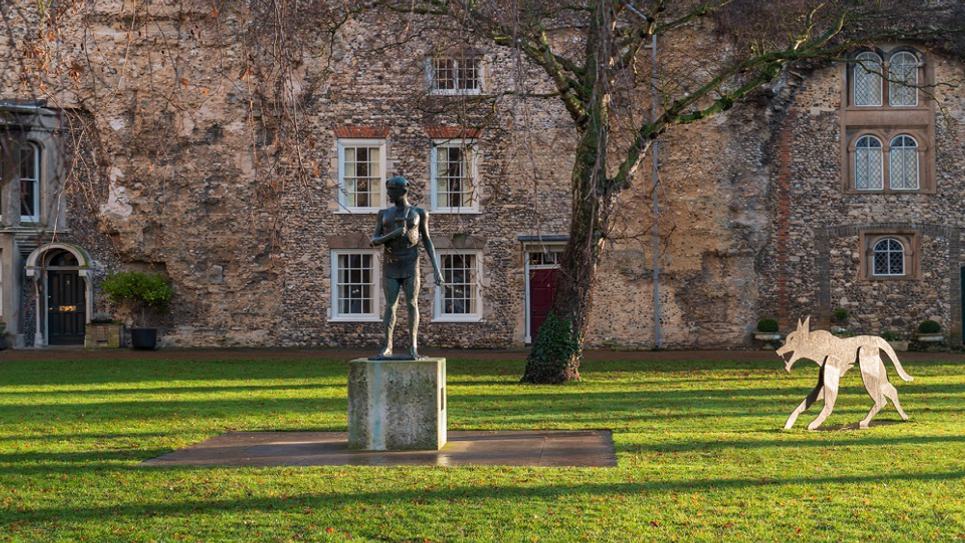
Back to Blogs
Discover
Interview with Historian Dr Francis Young
We quizzed Historian and Author Dr Francis Young on searching for St Edmund, his memories of Bury St Edmunds and which historical characters he'd have over for dinner!
A Q&A with Dr Francis Young

Francis Young is a UK-based historian and folklorist specialising in the history of religion and supernatural belief. He is the author of 14 books. His research interests include monasticism, saints, the history of magic and ritual (especially exorcism), early modern Catholicism, fairy belief, late medieval Ireland and the history of East Anglia (Suffolk, Norfolk and Cambridgeshire).
Francis Young’s book, Edmund – In Search of England’s Lost King, explores the theory that St Edmund’s remains lie beneath the tennis courts. He disentangles the man from the myth and tells of the mysterious life of St Edmund.
You have a doctorate in History from Cambridge University and are a Fellow of the Royal Historical Society. What made you fall in love with history?
I’ve been in love with history for as long as I can remember. As a child I especially loved history books illustrated by C. Walter Hodges, and was always asking my mum to make me historical costumes for dressing up!
Where did you discover an interest in religion and supernatural beliefs?
When I was studying A Level History at Culford School, the course on the English Reformation really caught my imagination. My then teacher, Alan Dures, introduced me to working with original documents.
At the time I was also giving guided tours of Hengrave Hall and wanted to research its history further. This led me to become interested in the history of Catholicism. The interest in supernatural beliefs came later, but it can probably be traced back to my teenage love for the ghost stories of M.R. James – another Bury historian!
You are the author of 14 books. How long does it take to research your books?
This depends a great deal on the nature of the book and how much access I have to the archives I need for my research, but it usually takes between a year and six months to complete a book. However, I started the research for my book about St Edmund five years before I actually wrote it.
What have you been up to during lockdown?
It’s been difficult losing access to books and manuscripts in the libraries I usually use, but I have had the chance to write up some projects I have been neglecting – and I’m working on a new book, although it has nothing to do with Bury St Edmunds this time!

You were born in Bury St Edmunds, what are your earliest memories of the town?
I was brought up close to the Suffolk Regiment Museum, St Peter’s Pits and the ‘Plague Stone’, so stories about these are some of my earliest memories.
I also spent a lot of time playing with my sister in the Abbey Ruins – I remember being absolutely baffled that these strange lumps of flint and mortar had ever been a great building, and found it very difficult to make sense of how it all fitted together.
Do you return to Bury St Edmunds often?
Not as often as I should like; my parents still live in Bury, but I no longer live nearby.
If you could recommend five places in Bury St Edmunds for visitors to see what would you recommend?
The Abbey Ruins, St Edmundsbury Cathedral, the Great Churchyard, St Mary’s Church and Moyse’s Hall Museum.
In your book ‘Edmund: In Search of England’s Lost King’ you set out why you think St Edmund is buried under the former tennis courts in the Abbey Gardens. This caused a huge amount of press coverage both national and local. Were you surprised?
I was surprised by the level of interest, yes – especially before any investigation had taken place! I think it was down to the recent discovery of the body of Richard III; the idea of finding another lost English king caught people’s imaginations.
But I’d stress that the idea that St Edmund is under the tennis courts is just a theory – we don’t have the same level of documentation as the Looking for Richard Project were working with.

The wildflower labyrinth where the old tennis courts stood and the site where Dr Francis Young believes could be St Edmund's final resting place
Who were St Edmund’s parents?
We just don’t know. We know from coins that he was preceded by a king called Æthelstan, who may have been his father. Alkmund and Siwara, the parents given to Edmund by Geoffrey of Wells, are entirely fictional characters.
Do you believe that St Edmund should be the Patron Saint of England and replace George?
I think England is big enough to have two patron saints. St George is an indelible part of English identity and can hardly be replaced, but the restoration of St Edmund is also wholly justified.
Some people argue that St George should be the patron saint of the country while St Edmund should be the patron of the English people; maybe that’s one way the saints can double up!
For those interested in St Edmund and the Abbey, apart from your books, where should they start to find out more?
A great place to start online is David Addy’s St Edmundsbury Chronicle at http://www.stedmundsburychronicle.co.uk which has become an enormous compendium of information on Bury’s history.

Why is Bury St Edmunds is such a special place?
I’m biased, of course, because I was born there, but no matter how many years I spend studying Bury’s history, I always find that my view of the town’s past is constantly being challenged and transformed by the discoveries I make.
The documentary evidence for the Abbey is absolutely vast – usually historians have the opposite problem of not enough evidence, but the challenge of dealing with Bury is getting to grips with so much material.
Bury is a place where the past can really come alive because we know so much. There are still many, many more books to be written about Bury’s history – it is a never-ending project!
What historical people would be at your fantasy dinner party?
I’d love to meet M.R. James, but I’m not sure we know enough about St Edmund to judge whether he would have been stimulating company at dinner!
Abbot Samson would certainly be an interesting dinner guest, although I find Abbot Baldwin (who was a pioneering doctor as well as an abbot) just as interesting.
And I’d like John Leland there, the antiquary who was one of the last people to see the Abbey still standing.
Related Posts
Related Blogs

News
Tours Take Off for Masters of…
Tours developed by Bury St Edmunds Tour Guides and…

News
Vote for Bury St Edmunds Tour…
Vote now to Help Bury St Edmunds Tour Guides win the…

News
See Rendlesham Revealed at…
1,400-year-old Anglo-Saxon artefacts from National…

News
New afternoon tea at Lavenham…
Enjoy a Masters of the Air themed afternoon tea at The…

News
Itinerary: Masters of the Air
Follow in the footsteps of the Master of the Air
Latest news

News
Discover Suffolk's County Flower - the Oxlip
Did you know that Suffolk has a county flower? The Oxlip only grows in some woodland areas of Suffolk, Cambridgeshire and Essex.

News
Quentin Blake ‘The Illustrated Hospital’ exhibition at Bury St Edmunds Museum
A summer exhibition of illustrations by Quentin Blake at Moyse’s Hall Museum, Bury St Edmunds presents a rare opportunity to view a large collection of pieces by one of the nation’s favourite artists.

News
Abbey Project Awarded National Lottery Heritage Fund Grant
The project aims to conserve and protect the ruins; build a visitor centre, west cloister, and network of footpaths; and use digital technology to provide exciting interpretation for all ages and…

News
Walks at Rougham
Rougham Estate offers 18 miles of public footpaths, cycling routes and permissive pathways for you to enjoy.

News
Bury St Edmunds Celebrates English Tourism Week
Bury St Edmunds MP, Jo Churchill, met representatives from the town’s attractions and tour guides involved with the town’s Masters of the Air tourism campaign at Bury St Edmunds Guildhall.

News
Tours Take Off for Masters of The Air
Tours developed by Bury St Edmunds Tour Guides and Bury St Edmunds Guildhall to tie in with the Apple TV Series Masters of The Air so popular more dates are being added.

News
International illustrator David Hughes draws largest exhibition Bury St Edmunds
The largest ever exhibition is now underway at Moyse’s Hall Museum featuring the work of internationally acclaimed illustrator David Hughes.

News
A Taste of Bury St Edmunds and Suffolk
After visiting Suffolk's foodie capital, you'll want to take it with you - here are 5 foodie treats to take home!

News
Doctor Who Stars Coming to Bury St Edmunds to Star in Sherlock Holmes Classic
Who stars Colin Baker, Terry Molloy, and Rosie Baker will star in Hound of The Baskervilles at Bury St Edmunds Theatre Royal



